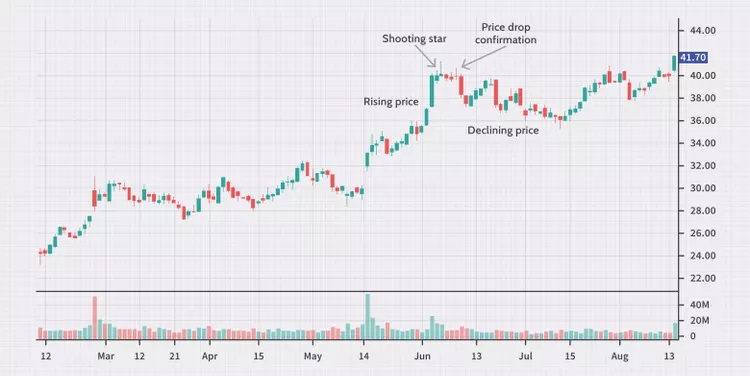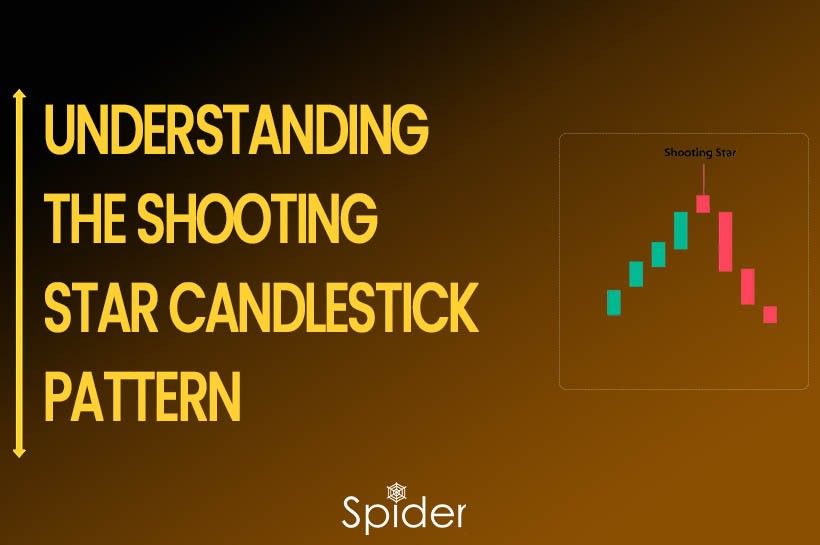A shooting star candlestick occurs when a stock rises after opening but falls back near the opening price by the end of the day.

The shooting star candlestick pattern resembles its name and can signal a potential end to an uptrend, suggesting a price drop may follow. It appears on candlestick charts, which offer a clearer view of price movements. The pattern features a small body and a long upper shadow, showing up at the peak of an uptrend. Recognizing this candlestick pattern helps traders time their entries and exits by spotting potential trend changes. We’ll explore its key features and how traders can use it in the market.
What Does the Shooting Star Candlestick Pattern Indicate?
The shooting star is like a warning sign that a market change could be coming. It doesn’t promise a reversal, but it suggests traders should be cautious. It shows a shift in market sentiment, indicating a change in the balance between buyers and sellers. Here’s a breakdown of what it means:
1. Initial Rise
The long upper wick (or “shadow”) of the shooting star shows a time when buyers were in control, pushing the price up from the opening. This rise could be caused by good news, strong market momentum, or high buying interest.
2. Sellers step in
Despite the strong buying at first, sellers start to take over, possibly thinking the stock is too expensive and deciding to take profits. This selling pressure stops the price from rising and pushes it back down.
3. The price falls back
The small body of the candlestick shows that by the end of the trading day, most or all of the gains were lost. If the body is red (or black on some charts), it means the price closed lower than it opened. A small green (or white) body means the price closed higher than it opened.
4. The buyers lose control
The long upper wick and small body show that buyers tried to drive the price up but couldn’t keep it there.
5. The upward momentum fades
The inability to maintain higher prices suggests the uptrend is losing strength, like the market is running out of energy to keep rising.
6. Selling pressure grows
The price reversal from high to low in one period usually shows that sellers are becoming more active, or that buying interest is fading.
7. Possible trend change
While one shooting star doesn’t guarantee a reversal, it acts as a warning. Traders often see it as a sign that the uptrend may be coming to an end.
Shooting Star Example
The shooting star shows the price went up after opening (long upper shadow), then dropped and closed near the opening price. If the stock closes lower the next day, it confirms the pattern. The high of the shooting star isn’t reached again, and the price starts a slow decline over the next month. When trading this pattern, a trader might sell their long positions once the next day closes lower, confirming the reversal.

Shooting Star Formation and Volume Analysis
The shooting star pattern, when paired with high volume, signals a stronger potential reversal. High volume means sellers are stepping in and overpowering buyers, making a reversal more likely. Traders often look for a price drop or confirmation, like a bearish candlestick, to confirm the trend change.
If the shooting star forms with low volume, the reversal signal is weaker, as it shows a lack of seller confidence. In this case, the price might keep rising, and the pattern could be invalid. Using volume with the shooting star helps traders judge whether the reversal is likely or if the uptrend will continue.
When the Pattern Fails
Pattern failure occurs when the expected price drop doesn’t happen, and the price keeps rising instead. This can happen due to lack of confirmation, strong market sentiment, or low volume.
Traders should consider the following when this happens:
1. Stick to your stop loss
If the price goes above the shooting star’s high, exit the trade quickly.
2. Learn from each failure
Review why the pattern didn’t work. Did you miss a larger market trend?
3. Refine your strategy
Use backtesting to find the most reliable confirmation signals for your market and timeframe.
4. Consider the bigger picture
Always analyze the shooting star in the context of other technical and fundamental factors.
5. Keep in mind
No pattern is foolproof. Successful trading is about managing risk and probabilities, not achieving perfection.
Limitations of Using the Shooting Star
One candlestick pattern alone, like the shooting star, isn’t very important in a strong uptrend. Prices fluctuate, so the brief control by sellers might not be significant.
That’s why confirmation is necessary—selling must continue, pushing prices lower after the shooting star. However, even with confirmation, there’s no guarantee the price won’t reverse upward. After a short decline, the price could continue rising with the overall uptrend.
Use stop losses to manage risk if the pattern doesn’t work out. Also, combine candlestick patterns with other analysis methods for better accuracy, especially when they align with key technical levels.
Power of Algorithms in Options Trading, Try Spider Now: Register Now
If you’d like to know how we analyze the market and provide accurate levels every day. then click on the Free Demo button below and change your trading life for good. 5X returns are possible in options trading If you have Spider Software in your trading system.
Disclaimer: The information provided in this Blog is for educational purposes only and should not be construed as financial advice. Trading in the stock market involves a significant level of risk and can result in both profits and losses. Spider Software & Team does not guarantee any specific outcome or profit from the use of the information provided in this Blog. It is the sole responsibility of the viewer to evaluate their own financial situation and to make their own decisions regarding any investments or trading strategies based on their individual financial goals, risk tolerance, and investment objectives. Spider Software & Team shall not be liable for any loss or damage, including without limitation any indirect, special, incidental or consequential loss or damage, arising from or in connection with the use of this blog or any information contained herein. ![]()





